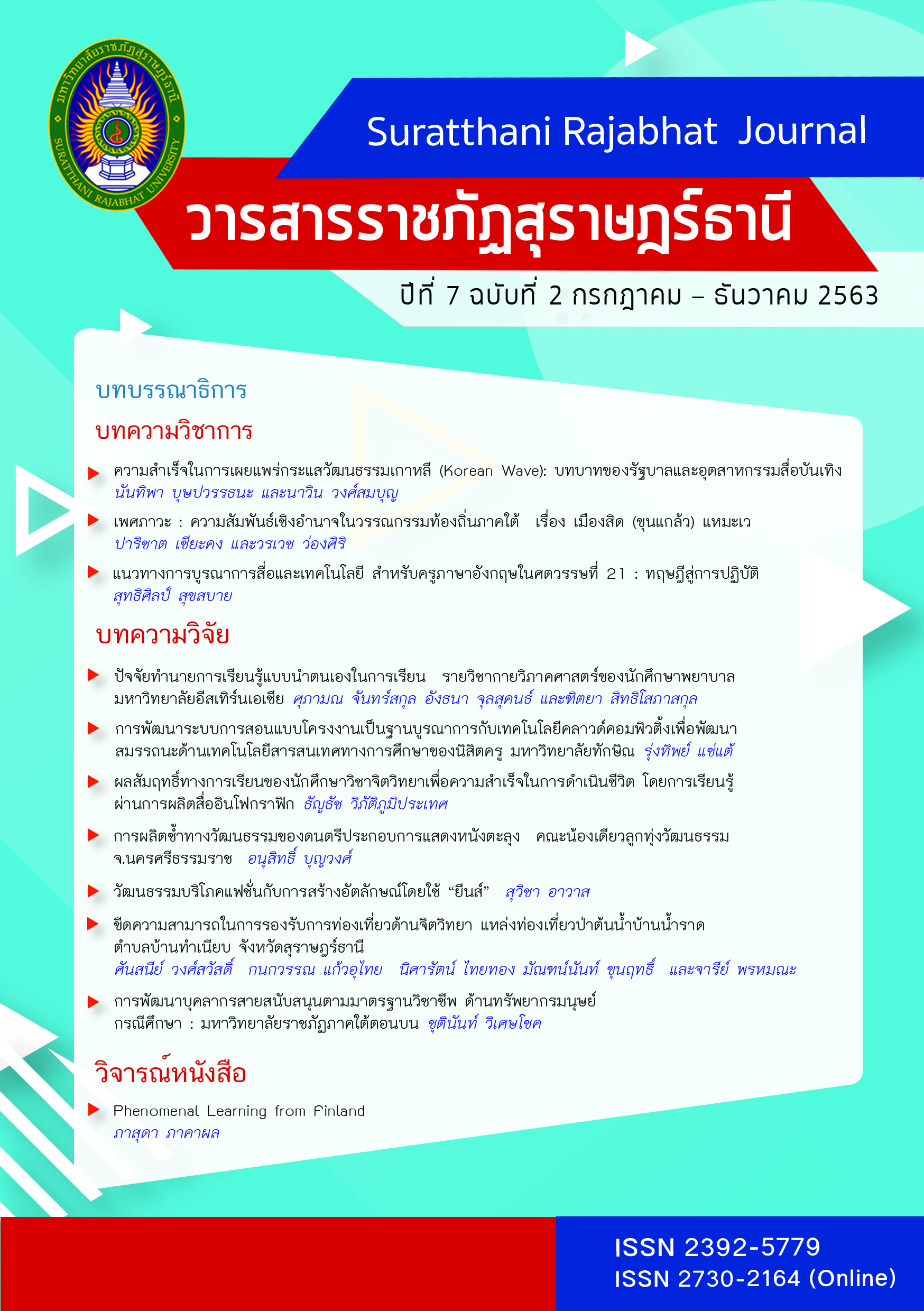A Guideline of Media and Technology Integration for Teachers of English in the 21st Century : Theories toward Implementation
Main Article Content
Abstract
Media and technology have played a significant role in learning and teaching contexts and stipulated teachers’ roles in the 21st century when there have been rapid changes in communication and information technology. Learners, therefore, need to have a competency to support their learning and living in order to overtake the change especially the ability to use technology as the tools to improve their knowledge and 21st century skills. Learning management of English as a key subject in accordance with the conceptual framework of 21st century skills found that the English learning of Thais could not reach the aim as expected according to the reported result of Ordinary National Education Test (O-NET) of the students in English subject indicating the score of lower than the criteria of 60. Thus, English teachers should remodel both traditional teaching methodology and beliefs to truly meet the changes and needs of 21st century learners. The 21st century teachers ought to have Technological Pedagogical Content Knowledge (TPACK) to methodically design learning activities for their learners in order to support the media and technology which unavoidably presents the key role in educational context.
Article Details
References
เจตน์สฤษฎิ์ สังขพันธ์ เก็ตถวา บุญปราการ และวันทนา ไกรฤกษ์. (2558). สภาพและปัญหาการเรียนรู้ภาษา อังกฤษของโรงเรียนระดับมัธยมศึกษาสังกัดเทศบาลในพื้นที่สามจังหวัดชายแดนภาคใต้.รายงานการประชุมหาดใหญ่วิชาการระดับชาติ ครั้งที่ 6 ณ มหาวิทยาลัยหาดใหญ่.พัฒนวิมล อิศรางกูร ณ อยุธยา. (2556). บริติชเคาน์ซิลลงนามในสัญญาการพัฒนาครู Boot Camp.สืบค้นเมื่อ 25 กันยายน 2560 จาก http://www.thaigov.go.th.วิจารณ์ พานิช. (2555). วิถีสร้างการเรียนรู้เพื่อศิษย์ในศตวรรษที่21.กรุงเทพฯ: มูลนิธิ สดศรี-สฤษดิ์วงศ์.วิโรจน์ สารรัจนะ. (2556). กระบวนทัศน์ใหม่ทางการศึกษากรณีทัศนะต่อการศึกษาศตวรรษที่ 21.กรุงเทพฯ: หจก.ทิพยวิสุทธิ์.สถาบันทดสอบทางการศึกษาแห่งชาติ. (2562). สรุปผลการทดสอบทางการศึกษาระดับชาติขั้นพื้นฐาน (O-NET)ชั้นมัธยมศึกษาปีที่ 6 ปีการศึกษา 2561.สืบค้นเมื่อ 10 กุมพาพันธ์ 2563 จาก http://www.newonetresult.niets.or.th/AnnouncementWeb/PDF/SummaryONETM6_2561.pdf.ส านักงานพัฒนาทางธุรกรรมทางอิเล็กทรอนิกส์. (2562). รายงานประจำปี สพธอ. 2562 (ETDA Annual Report 2019).สืบค้นเมื่อ 10 กุมพาพันธ์ 2563 จาก https://www.etda.or.th/publishing-detail/etda-annual-report-2019.html.
เสาวภาคย์ ศรีโยธา. (2555). ปัญหาการเรียนภาษาอังกฤษระดับชั้นมัธยมศึกษาปีที่ 3 ในโรงเรียนขยายโอกาส สังกัดส านักงานเขตพื้นที่การศึกษาประถมศึกษาพัทลุง เขต 1. สารนิพนธ์ศิลปศาสตรมหาบัณฑิต สาขาวิชาการสอนภาษาอังกฤษเป็นภาษานานาชาติ มหาวิทยาลัยสงขลานครินทร์.
สุทธิศิลป์ สุขสบาย. (2562). การบูรณาการรูปแบบแอสชัวร์ในการสอนแบบทีพีซีเคเพื่อพัฒนาทักษะภาษาอังกฤษของนักศึกษาระดับปริญญาตรี.สุราษฎร์ธานี: มหาวิทยาลัยราชภัฏสุราษฎร์ธานี
อนุชัย ธีระเรืองไชยศรี. (2561). ข้อก าหนดการพัฒนารายวิชาเพื่อการเรียนการสอนในระบบเปิด (ThaiMOOC) ระยะที่ 2. โครงการพัฒนารายวิชาเพื่อการเรียนการสอนในระบบเปิด (ThaiMOOC)ระยะที่ 2.กรุงเทพฯ: ส านักงานคณะกรรมการอุดมศึกษา.
อินทิรา ศรีประสิทธ์. (2552). 7 ขั้นตอนที่จะท าให้คนไทยเก่งภาษาอังกฤษอย่างถาวรและแท้จริง.สืบค้นเมื่อ 25 กันยายน 2560 จาก http://www.oknation.com.
Aghaei, S., Nematbakhsh, M. A., & Farsani, H. K. (2012). Evolution of the World Wide Web: From Web 1.0to Web 4.0. International Journal of Web & Semantic Technology (IJWesT),3(1), 1-10.
Erdogan, A. & Sahin, I. (2010). Relationship between math teacher candidates’ Technological Pedagogical and Content Knowledge (TPACK) and achievement levels.Procedia-Social and Behavioral Sciences, 2(2),2707-2711.
Heinich, R., Molenda, M., Russell, J.D. & Smaldino, S. (1999). Instructional Media andTechnologies for Learning (6th Ed).Columbus, OH: Prentice-Hall.Mishra, P. & Koehler, M.J. (2006). Technology pedagogical content knowledge: A framework for integrating technology in teacher knowledge. Teacher College Record,108(6), 1017-1054.
Norton, S., McRobbie, C. J. & Cooper, T. J. (2000). Exploring secondary mathematics teachers’reasons for not using computers in their teaching: five case studies. Journal of Research on Computing in Education, 33(1), 87.
Partnership for 21st Century Skills. (2009).21stCentury Skills.Retrieved September 25, 2017, from http://www.p21.org.
Pelgrum, W. (2001). Obstacles to the integration of ICT in education: results from a worldwide educational assessment. Computers and Education, 37(2), 163-178.
Shamburg, C. (2004). Conditions that inhibit the integration of technology for urban early childhood teachers. Information Technology in Childhood Education Annual, 2004(1), 227-244.
Shulman, L.S. (1986). Knowledge and teaching: Foundations of the new reform. Harvard Educational Review,57(1): 1-22.


